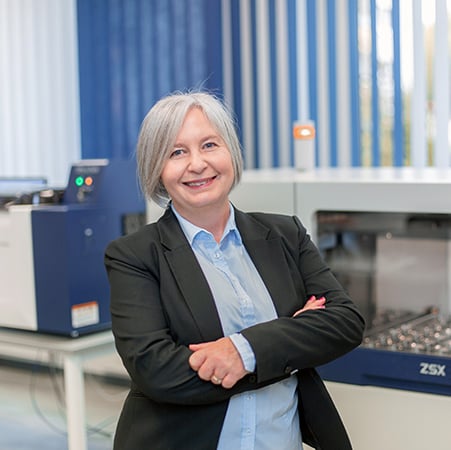Application Note WDXRF1070
Introduction
It is important to control the chlorine content of FCC catalyst to guard against the formation of hazardous organochloride compounds such as dioxins and to prevent degradation of catalytic activity. This application note documents the performance of a Rigaku ZSX Primus series spectrometer for analysis of chlorine in FCC aluminosilicate catalyst.
Instrument and measurement condition
| X-ray tube | End window; Rh target |
| Element line | Cl-Kα |
| kV-mA | 30-130 |
| Analysis area | 30 mm in diameter |
| Slit | S2 (fine) |
| Analyzing crystal | GeH |
| Detector | F-PC |
| Counting time | 20 s for peak 10 s for BG |
Sample preparation
Powder samples were pressed into a 32 mm I.D. alu-minum support ring at 150 kN to form a briquette with flat, smooth surface.
Calibration curve
A calibration curve was made using four aluminosilicate house standard samples and a high-purity silica powder (Cl blank) as seen in Figure 1.

Figure 1: Calibration curve of Cl
Table 1: Repeatability test result
| Run# | Cl in ppm |
| 1 | 60 |
| 2 | 59 |
| 3 | 61 |
| 4 | 59 |
| 5 | 55 |
| 6 | 61 |
| 7 | 56 |
| 8 | 55 |
| 9 | 57 |
| 10 | 56 |
| Average | 58 |
| Standard deviation | 2.3 |
| RSD% | 4.0% |
Table 2: Estimated precision at typical concentrations
| Cl conc. (ppm) | Counting time Peak 20 s / BG 10 s | Counting time Peak 200 s / BG 100 s | ||
| Precision (ppm) | RSD% | Precision (ppm) | RSD% | |
| 1000 | 5.7 | 0.57% | 1.8 | 0.18% |
| 500 | 4.3 | 0.85% | 1.4 | 0.27% |
| 100 | 2.7 | 2.69% | 0.8 | 0.85% |
| 50 | 2.4 | 4.83% | 0.8 | 1.53% |
| 10 | 2.2 | 21.7% | 0.7 | 6.88% |
| 5 | 2.1 | 42.9% | 0.7 | 13.6% |
Measurement precision and detection limit
An aluminosilicate sample containing about 60 ppm Cl was measured ten times to demonstrate the precision of analysis. The test results are summarized in Table 1. The lower limit of detection (LLD) for chlorine was estimated from the slope of the calibration curve and the intensity of the pure silica blank. The estimated LLD based on the formula below is 1.2 ppm Cl.
$LLD = 3 \cdot s \cdot \sigma_B = 3 \cdot s \cdot \sqrt{\frac{I_B}{1000 \cdot t}}$
$s$ : slope of the calibration curve (ppm/kcps)
$σ_B$ : standard deviation of blank intensity (kcps)
$I_B$ : intensity of the blank (kcps)
$t$ : counting time (s); 100 s is used
Estimated precision
Standard deviations at representative concentrations of chlorine in aluminosilicate samples were estimated. Table 2 shows the standard deviation and RSD% not only for the counting time used for calibration (20 seconds at peak and 10 seconds at background) but also for a longer counting time (200 seconds at peak and 100 seconds at background).
When analyzing trace levels of chlorine such as 10 ppm, it is advisable to use a longer counting time to improve counting statistics.
Conclusion
This application note demonstrates that chlorine can be quantified reliably at trace levels of concentration in aluminosilicate materials such as FCC catalyst using a pressed powder method and Rigaku ZSX Primus series spectrometer.
The ZSX Primus II and ZSX Primus IV are particularly suitable for aluminosilicate analysis by a pressed pellet method because of their tube-above optics, where any inadvertent scattering of loose powder particles inside the spectrometer chamber and onto the X-ray tube and optical components is minimized compared to tube-below designs.
The tube-above optical design also eliminates the need to add a binder in order to increase the stability of the briquettes as is recommended for tube-below designs. The ZSX PrimusII and ZSX Primus IV are further optimized for analysis of powder samples with features such as a user-selectable evacuation rate (slow or fast) to guard against cracking of briquetted specimens and a powder trap.

